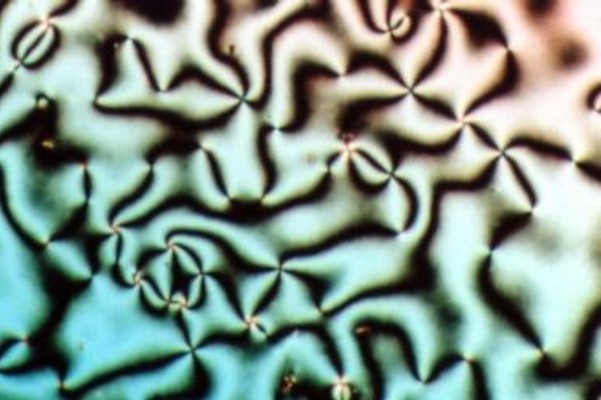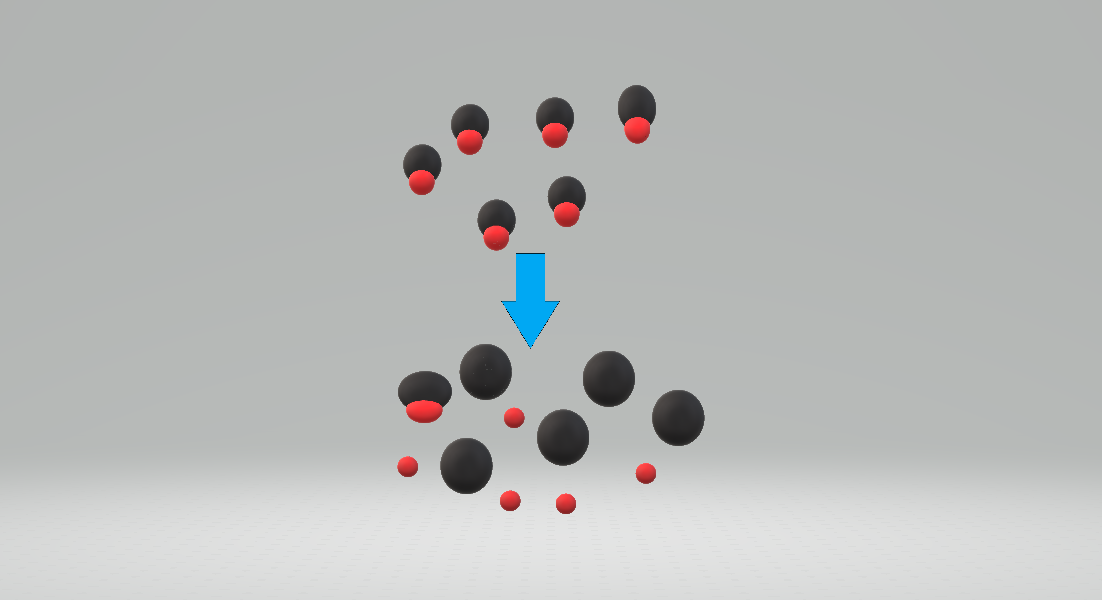|
Thermochromism
Thermochromism is the property of substances to change color due to a change in temperature. A mood ring is an example of this property used in a consumer product although thermochromism also has more practical uses, such as baby bottles, which change to a different color when cool enough to drink, or kettles which change color when water is at or near boiling point. Thermochromism is one of several types of chromism. Organic materials Thermochromatic liquid crystals The two common approaches are based on liquid crystals and leuco dyes. Liquid crystals are used in precision applications, as their responses can be engineered to accurate temperatures, but their color range is limited by their principle of operation. Leuco dyes allow wider range of colors to be used, but their response temperatures are more difficult to set with accuracy. Some liquid crystals are capable of displaying different colors at different temperatures. This change is dependent on selective reflection of ... [...More Info...] [...Related Items...] OR: [Wikipedia] [Google] [Baidu] |
Thermochromatic Ink
Thermochromic ink (also called thermochromatic ink) is a type of dye that changes color in response to a change in temperature. It was first used in the 1970s in novelty toys like mood rings, but has found some practical uses in things such as thermometers, product packaging, and pens. The ink has also found applications within the medical field for specific medical simulations in medical training. Thermochromic ink can also turn transparency and translucency, transparent when heat is applied; an example of this type of ink can be found on the corners of an Test (assessment), examination mark sheet to prove that the sheet has not been edited or photocopied. Composition There are two main variants of thermochromic ink, one composed of leuco dyes and one composed of liquid crystals. For both types of ink, the chemicals need to be contained within capsules around 3 to 5 Micrometre, microns long. This protects the dyes and crystals from mixing with other chemicals that might affect the ... [...More Info...] [...Related Items...] OR: [Wikipedia] [Google] [Baidu] |
Hypercolor
Hypercolor was a line of clothing, mainly T-shirts and shorts, that changed color with heat. They were manufactured by Generra Sportswear Company of Seattle and marketed in the United States as Generra Hypercolor or Generra Hypergrafix and elsewhere as Global Hypercolor. They contained a thermochromic pigment made by Matsui Shikiso Chemical of Japan, that changed between two colors—one when cold, one when warm. The shirts were produced with several color change choices beginning in 1991. The effect could easily be permanently damaged, particularly when the clothing was washed in hotter than recommended water, ironed, bleached, or tumble-dried. Generra Sportswear Co. had originally been founded as a men's sportswear distributor and importer in Seattle in 1980. The company was sold to Texas-based Farah Manufacturing Co. in 1984 and bought back by its founders in 1989. In 1986, the company added childrenswear and womenswear items to their portfolio. They struggled to meet the ... [...More Info...] [...Related Items...] OR: [Wikipedia] [Google] [Baidu] |
Liquid Crystals
Liquid crystal (LC) is a state of matter whose properties are between those of conventional liquids and those of solid crystals. For example, a liquid crystal can flow like a liquid, but its molecules may be oriented in a common direction as in a solid. There are many types of LC phases, which can be distinguished by their optical properties (such as textures). The contrasting textures arise due to molecules within one area of material ("domain") being oriented in the same direction but different areas having different orientations. An LC material may not always be in an LC state of matter (just as water may be ice or water vapour). Liquid crystals can be divided into three main types: thermotropic, lyotropic, and metallotropic. Thermotropic and lyotropic liquid crystals consist mostly of organic molecules, although a few minerals are also known. Thermotropic LCs exhibit a phase transition into the LC phase as temperature changes. Lyotropic LCs exhibit phase transitions a ... [...More Info...] [...Related Items...] OR: [Wikipedia] [Google] [Baidu] |
Mood Ring
A mood ring is a finger ring that contains a thermochromic element, or "mood stone", that changes colors based on the temperature of the finger of the wearer. Finger temperature, as long as the ambient temperature is relatively constant, is significantly determined by peripheral blood flow. A mood ring contains liquid crystals that change color depending on the temperature. History The idea to use thermosensitive elements in jewelry first arose from the American jeweler Marvin Wernick in 1974 after reading a magazine article about the use of liquid crystal elements in medical thermometers. He found a compound that changed color from black to green, blue and deep blue in the range of 32–38 °C and in January 1975 developed a technique for using it in pendants and rings. Sales began in February. Wernick called the jewelry "magical", and his promotional materials claimed that the color of the pendant or ring is an indicator of the warmth of the wearer's character. Since Werni ... [...More Info...] [...Related Items...] OR: [Wikipedia] [Google] [Baidu] |
Chromism
In chemistry, chromism is a process that induces a change, often reversible, in the colors of compounds. In most cases, chromism is based on a change in the electron states of molecules, especially the π- or d-electron state, so this phenomenon is induced by various external stimuli which can alter the electron density of substances. It is known that there are many natural compounds that have chromism, and many artificial compounds with specific chromism have been synthesized to date. It is usually synonymous with chromotropism, the (reversible) change in color of a substance due to the physical and chemical properties of its ambient surrounding medium, such as temperature and pressure, light, solvent, and presence of ions and electrons. Chromism is classified by what kind of stimuli are used. Examples of the major kinds of chromism are as follows. * thermochromism is chromism that is induced by heat, that is, a change of temperature. This is the most common chromism of all. * ... [...More Info...] [...Related Items...] OR: [Wikipedia] [Google] [Baidu] |
Liquid Crystal
Liquid crystal (LC) is a state of matter whose properties are between those of conventional liquids and those of solid crystals. For example, a liquid crystal can flow like a liquid, but its molecules may be oriented in a common direction as in a solid. There are many types of LC Phase (matter), phases, which can be distinguished by their Optics, optical properties (such as Texture (crystalline), textures). The contrasting textures arise due to molecules within one area of material ("domain") being oriented in the same direction but different areas having different orientations. An LC material may not always be in an LC state of matter (just as water may be ice or water vapour). Liquid crystals can be divided into three main types: thermotropic, lyotropic, and #Metallotropic liquid crystals, metallotropic. Thermotropic and lyotropic liquid crystals consist mostly of organic molecules, although a few minerals are also known. Thermotropic LCs exhibit a phase transition into the L ... [...More Info...] [...Related Items...] OR: [Wikipedia] [Google] [Baidu] |
Dodecanol
Dodecanol , or lauryl alcohol, is an organic compound produced industrially from palm kernel oil or coconut oil. It is a fatty alcohol. Sulfate esters of lauryl alcohol, especially sodium lauryl sulfate, are very widely used as surfactants. Sodium lauryl sulfate and the related dodecanol derivatives ammonium lauryl sulfate and sodium laureth sulfate are all used in shampoos. Dodecanol is tasteless, colorless, and has a floral odor. Production and use In 1993, the European demand of dodecanol was around 60,000 tonnes per year. It can be obtained from palm oil or coconut oil fatty acids and methyl esters by hydrogenation. It may also be produced synthetically via the Ziegler process. A classic laboratory method involves Bouveault-Blanc reduction of ethyl laurate. Dodecanol is used to make surfactants, which are used in lubricating oils, and pharmaceuticals. Millions of tons of sodium dodecylsulfate (SDS) are produced annually by sulfation of dodecyl alcohol: : : Dodecanol is ... [...More Info...] [...Related Items...] OR: [Wikipedia] [Google] [Baidu] |
Crystal Violet Lactone
Crystal violet lactone (CVL) is a leuco dye, a lactone derivate of crystal violet 10B. In pure state it is a slightly yellowish crystalline powder, soluble in nonpolar or slightly polar organic solvents. The central carbon in the leuco form is in a tetrahedral configuration, with four covalent bonds. In an acidic environment, the lactone ring is broken, with the oxygen detaching from the central carbon. This now-trivalent position is a planar carbocation that is resonance stabilized, interconnecting the π systems of the aromatic rings and the amino functional groups. This single large conjugated system is a chromophore with strong absorption in visible spectrum, giving this compound its distinctive color. This chemical is usually drawn in the resonance structure with the cation on nitrogen. : It was the first dye used in carbonless copy papers, and it is still widely used in this application. It is also the leuco dye component in some thermochromic dyes, e.g. in the Hypercolo ... [...More Info...] [...Related Items...] OR: [Wikipedia] [Google] [Baidu] |
Weak Acid
Acid strength is the tendency of an acid, symbolised by the chemical formula , to dissociate into a proton, , and an anion, . The dissociation or ionization of a strong acid in solution is effectively complete, except in its most concentrated solutions. : Examples of strong acids are hydrochloric acid (), perchloric acid (), nitric acid () and sulfuric acid (). A weak acid is only partially dissociated, or is partly ionized in water with both the undissociated acid and its dissociation products being present, in solution, in equilibrium with each other. : Acetic acid () is an example of a weak acid. The strength of a weak acid is quantified by its acid dissociation constant, K_a value. The strength of a weak organic acid may depend on substituent effects. The strength of an inorganic acid is dependent on the oxidation state for the atom to which the proton may be attached. Acid strength is solvent-dependent. For example, hydrogen chloride is a strong acid in aqueous solu ... [...More Info...] [...Related Items...] OR: [Wikipedia] [Google] [Baidu] |
Fluoran
Fluoran is a triarylmethane dye. It is the structural core of a variety of other dyes. These dyes have a variety of applications such as chemical stains (for example eosins) and in thermal paper Thermal paper (often supplied in roll form, and sometimes referred to as an audit roll) is a special fine paper that is coated with a material formulated to change color locally when exposed to heat. It is used in thermal printers, particularly .... Black 305 is a common leuco dye product for thermal paper. References Triarylmethane dyes Spiro compounds Lactones {{organic-compound-stub ... [...More Info...] [...Related Items...] OR: [Wikipedia] [Google] [Baidu] |




